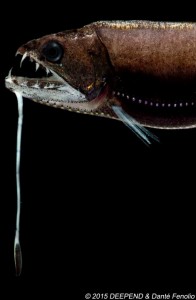NSU Newsroom
SharkBytes
Horizons
This version of NSU News has been archived as of February 28, 2019. To search through archived articles, visit nova.edu/search. To access the new version of NSU News, visit news.nova.edu.
This version of SharkBytes has been archived as of February 28, 2019. To search through archived articles, visit nova.edu/search. To access the new version of SharkBytes, visit sharkbytes.nova.edu.
Research Spotlight: Halmos Faculty Identify More than 180 Species of Fish
 Halmos faculty member Tracey Sutton, Ph.D. and other scientists of the DEEPEND consortium have identified over 180 fish species new to the Gulf of Mexico and another 20-30 that are new to scientists. Most of these species come from the deep waters of the Gulf, where little research has been conducted. “People don’t fish it and it requires specialized gear. Research vessel time is fairly expensive,” Sutton said.
Halmos faculty member Tracey Sutton, Ph.D. and other scientists of the DEEPEND consortium have identified over 180 fish species new to the Gulf of Mexico and another 20-30 that are new to scientists. Most of these species come from the deep waters of the Gulf, where little research has been conducted. “People don’t fish it and it requires specialized gear. Research vessel time is fairly expensive,” Sutton said.
After four years of sampling, Sutton’s group found over 1600 species of fish in the Gulf. This is at least a 10% increase from the last count. Included in this count are never before seen fish, several called dragon fishes. “They’re quite horrible looking,” Sutton said. “They are fish with big teeth and a lure hanging off their chin that has a light organ hanging on the end to lure prey.”
The DEEPEND consortium is part of the Gulf of Mexico Research Initiative. This was created as a result of the 2010 BP Deepwater Horizon oil spill. As part of their settlement, the oil company was required to give $500 million to 20 independent researches to explore the Gulf’s deep waters.